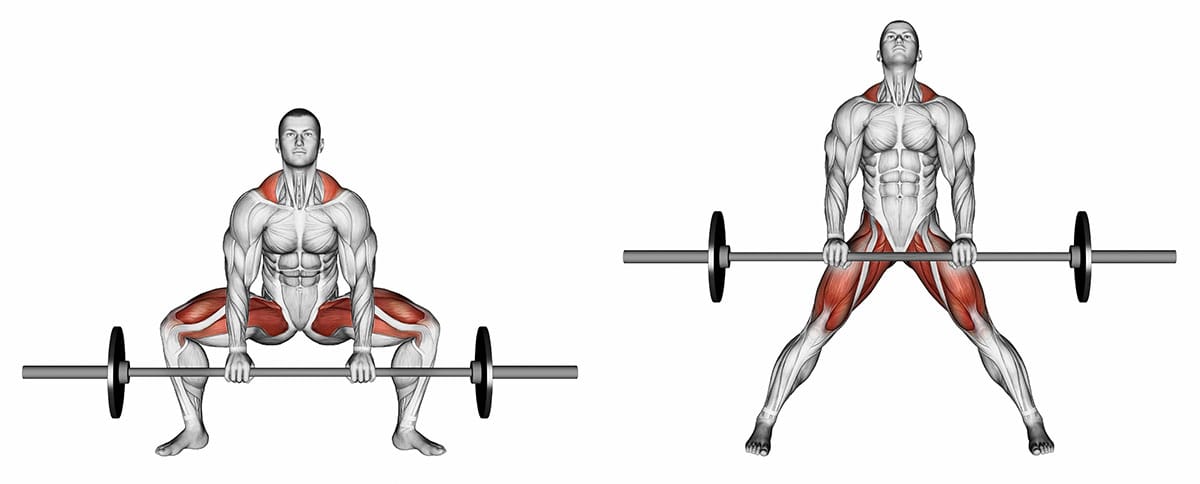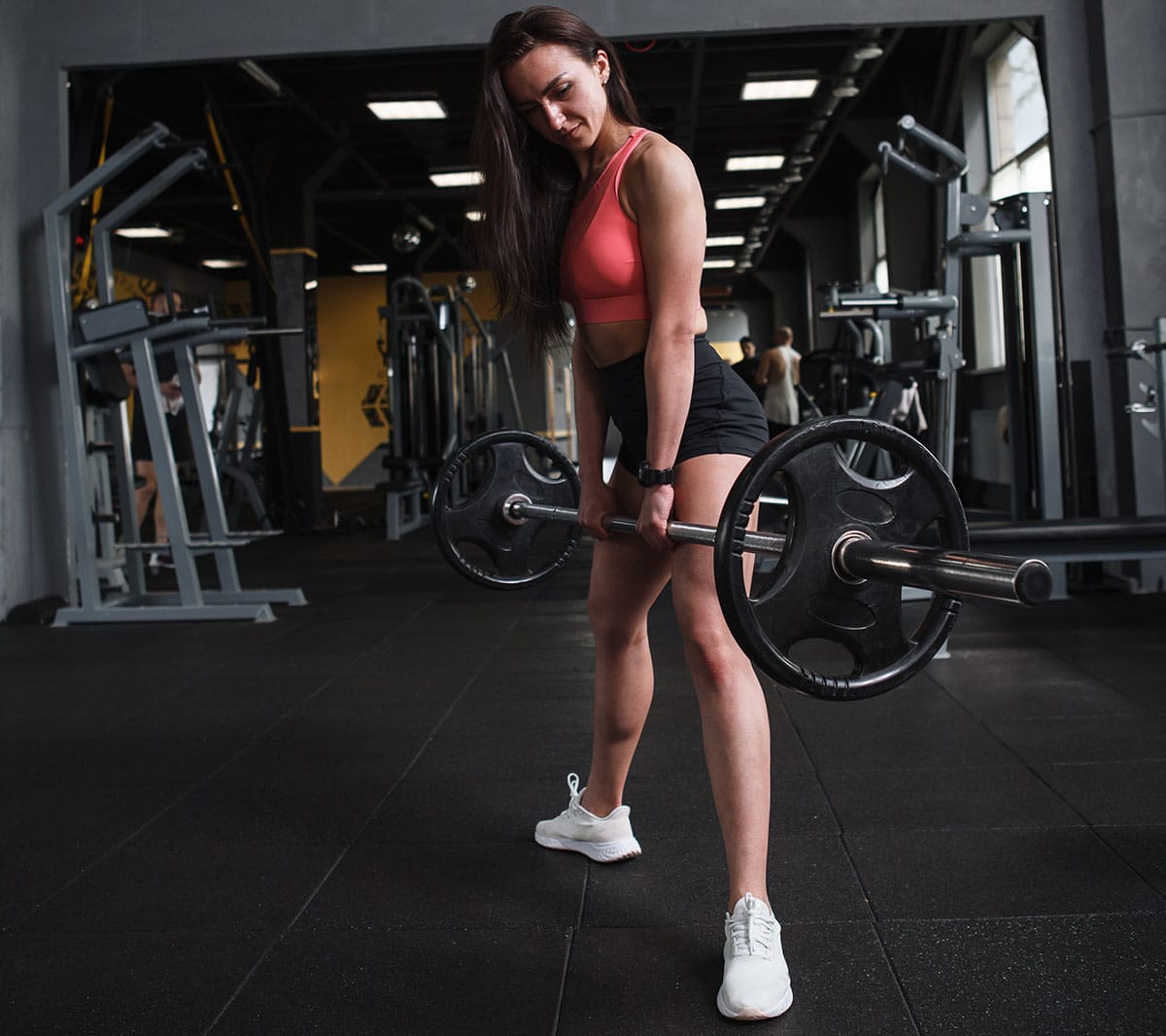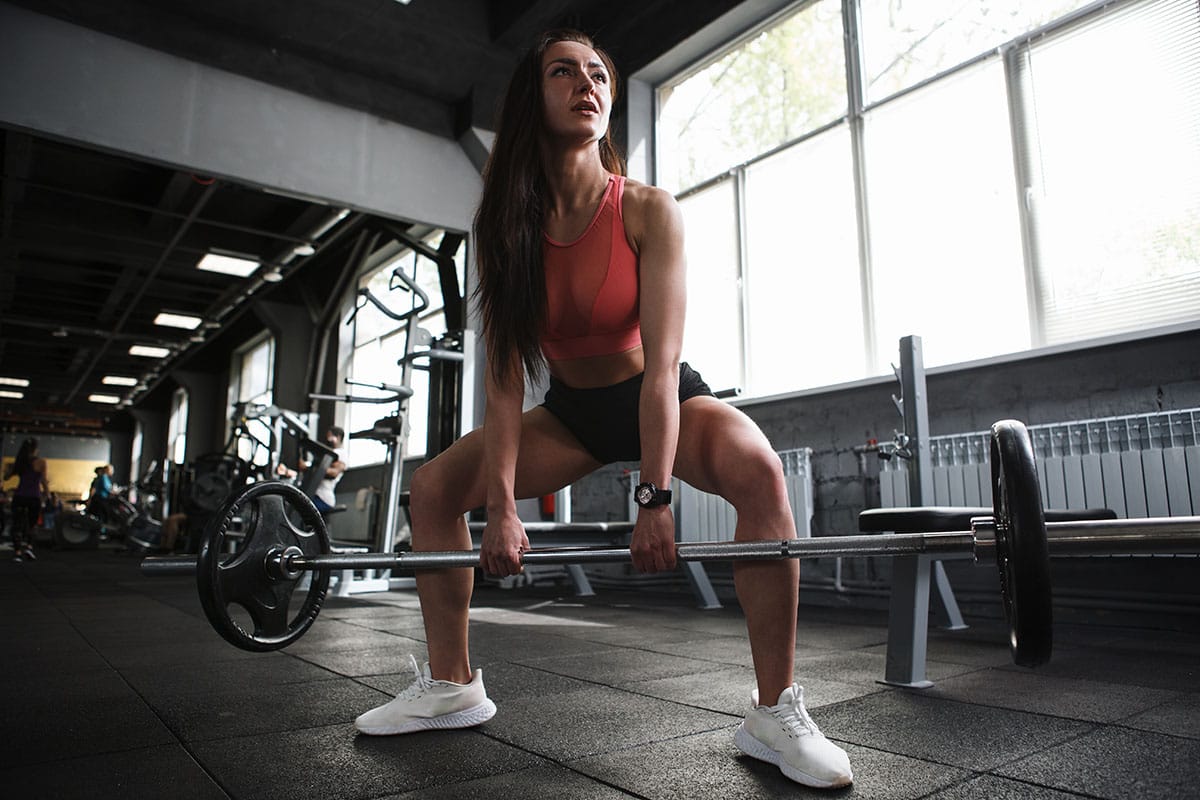Sumo RDLs: Boost Glute Strength, Hip Mobility, and Stability
If you’re looking for a move that combines the benefits of Romanian deadlifts and sumo deadlifts, look no further.
The sumo RDL truly gives you the best of both worlds!
Keep reading to learn how you can perform sumo RDLs, why they’re so beneficial for your posterior chain, and how you can incorporate them into your workout routine for stronger glutes, hamstrings, and inner thighs.
All About Sumo RDLs
A sumo Romanian Deadlift (sumo RDL) is a compound exercise and variation of the traditional Romanian deadlift focusing on your hamstrings, glutes, and adductors (inner thighs).

This exercise blends the wide stance you use in a sumo deadlift with the hip hinge of a traditional Romanian deadlift (RDL). Sumo RDLs mainly target your entire posterior chain, aka the muscles at the back of your body.
They also help you engage your inner thighs more effectively because of the widened stance.
Take a look at how to perfectly perform this exercise.
How to Do a Sumo RDL
1. Set-Up
Stand with your feet wider than shoulder-width apart. Keep your toes pointed slightly outward. This is your sumo stance.
Hold a barbell, dumbbell, or kettlebell with an overhand grip in front of your thighs.
2. Body Position
Keep your chest proud with your shoulders back and core engaged.
Your knees should be slightly bent, but don’t lock them out. Most of your movement should come from hinging at the hips, not a knee bend.
3. Action
Push your hips back as you lower your weight towards the ground. Keep your weight tracking close to your legs, thinking of sliding it down your shins as you move.
Keep your spine flat and lower your weight until you feel a stretch in your hamstrings. Don’t round out your back. Only go until you feel a slight pull in the hamstrings but you can maintain a flat back position.
4. Reverse
From here, drive your hips forward and return to your starting position. Squeeze your glutes at the top of the movement.
5. Reps
3-4 sets of 8-12 reps.
The Sumo RDL is a great exercise for improving posterior chain strength and flexibility, especially for those who want to emphasize the inner thighs and glute
Sumo RDL Benefits
Now, let's see what are the advantages of doing this exercise:

1. Tone Those Inner Thighs
Using a wide stance like you would in a sumo RDL puts more emphasis on your adductors. If you want to target this area for strength and tone, this is a great move to work on.
It’s an area that’s often neglected in many lower body exercises, even though many gymgoers cite the thighs as a problem area aesthetically.
By training your inner thighs with moves that are meant for them, you’ll create more balance to your leg muscles.
2. Increased Hip Mobility
Standing in sumo gives you a much wider horizontal range of motion at the hips. This is a great way to encourage hip flexibility and mobility, especially if you find your hips tight from sitting all day.
Other exercises you can do with sumo position are sumo squats and kettlebell sumo squats.
3. Nicer Glutes
Sumo RDLs are great for glute engagement, especially your gluteus maximus (the largest glute muscle) during the hip-hinge movement. If you want to build more overall strength and size to aim for a shelf butt or heart-shaped ass, this move is even more effective than conventional RDLs to help you build some majestic buns.
4. Pain-Free Lower Back
Your wide foot position forces you to keep your torso more upright in a sumo RDL than you would in a conventional RDL.
If your back tends to get sore, this foot positioning is a solid option to help alleviate strain on your lower back while still hammering your glutes, hamstrings, and inner thighs.
An upright torso during the movement can reduce strain on the lower back compared to traditional deadlifts or RDLs. This makes it a good option for individuals who want to train the posterior chain with less risk to the lower back.
5. Keeps You Balanced
The wide stance requires more balance and stability from the hips, core, and legs, improving coordination and overall stability. This can translate to better performance in other exercises and movements that require a strong, stable base.
These benefits make the sumo RDL a versatile exercise for developing lower body strength, mobility, and stability while reducing strain on the lower back.
Full-Body Weekly Workout Plan (Emphasis on Sumo RDLs)
Day 1: Lower & Core
- Sumo RDLs – 4 sets X 8-10 reps
- Bulgarian split squats – 3 sets X 8-10 reps per leg
- Plank holds – 3 X 45 seconds
Day 2: Upper Body Push Day Workout
- Bench press – 4 sets of 8-10 reps
- Military press or shoulder press – 3 sets of 8-10 reps
- Push-ups – 3 sets to failure
Day 3: Rest & Recover
- Take a day off, stretch, or try some light cardio (walking, cycling, gentle yoga, etc.) – 20-30 minutes
Day 4: Lower Body & Core
- Sumo RDLs – 4 sets X 8-10 reps
- Goblet squats – 3 sets X 10-12 reps
- Russian twists – 3 sets X 15 per side
Day 5: Upper Body Pull Day Workout
- Wide grip lat pulldowns – 3-4 sets X 8-10 reps
- Dumbbell rows – 3 sets X 10-12 reps each arm
- Barbell or dumbbell curls – 3 sets X 10-12 reps
Day 6: Full Body Conditioning
- Sumo RDLs – 3 sets X 10 reps (use a lighter weight)
- Kettlebell swings – 3 sets X 15 reps
- Burpees – 3 sets X 10-12 reps

Day 7: Rest
- Light stretching – 15-20 minutes
- Foam rolling or muscle scraping – 10-15 minutes
Every exercise in this plan is a suggestion, so feel free to mix and match these moves as needed.
Remember, if you want to use this plan as a template for multiple weeks, it’s a good idea to continue increasing your weights for progressive overload as you begin to get stronger.
A tracking app like Flex Fitness can help you keep a simple log of what weights you’re working with each week so you don’t have to rack your brain to remember where you started. That way, you devote more focus to your workouts!
Sumo RDL Muscles Worked
Sumo Romanian Deadlifts (Sumo RDLs) primarily target the posterior chain but also engage other muscle groups due to the wide stance. Here’s a breakdown of the key muscles worked and their functions:
1. Hamstrings
The hamstrings are the muscles at the backs of your thighs responsible for knee flexion (bending your knees) and hip extension (pushing your hips forward). In a sumo RDL, they help your hip hinge to lower your weight.
2. Glutes
Your glutes, especially the gluteus maximus (your largest butt muscle), are responsible for hip extension and keeping your pelvis stable. When you do sumo RDLs, they help you push your hips forward when you come up to a standing position.
3. Adductors (Inner Thigh Muscles)
Your inner thigh muscles pull your legs toward your body’s midline, as well as keeping your hips stable. In a wide sumo stance, they help keep your movement controlled and stabilize your legs so your knees don’t knock too far in or out.
4. Lower Back (Erector Spinae)
The erector spinae is a group of 3 back muscles that run the length of your spine: the iliocostalis, longissimus, and spinalis.
These muscles help you hold your posture upright, stabilizing your spine as you lift and lower your weight in sumo RDLs.
5. Core Muscles (Abdominals and Obliques)
Your core helps hold your spine and pelvis in place during heavy lifts. In Sumo RDLs, these muscles stop your torso from collapsing forward. This can be important to prevent injuries or equipment malfunctions.
To hold your weight, sumo RDLs also require some assistance from your:
- Forearms
- Trapezius (traps)
The hamstrings, glutes, and adductors are your main or “primary mover” muscles. Your lower back, core, and forearms play important stabilizing roles and are secondary actors here.
Sumo RDL— FAQ
What is the difference between a deadlift and an RDL?
A deadlift starts from the floor. You pick your bar up first before working through your reps.
A Romanian Deadlift (RDL) starts with the bar lifted, and you lower from here to complete your reps.
Typically, the RDL also requires a deeper hip hinge to drive your motion, while a conventional deadlift operates with your knee bend as the main driver instead. Check out the comparison between deadlift vs RDL to see which is a better exercise for you.
What is the difference between RDL and sumo RDL?
A sumo RDL is just a Romanian Deadlift using a sumo stance for your feet. What is the sumo stance? You place your feet wider than shoulder-width apart (you can even place them as wide as they will go if it’s comfortable for you). The toes should also point slightly outward.
In a traditional RDL, you usually want to work with the feet hip-width apart. Here, your toes should point straight forward.
What type of RDL is best for the glutes?
There are a few RDL variations that are considered among the best for working your glutes. These include:
Trap bar RDL
- Why? Using a trap bar or hexagonal barbell keeps more of the load at hip level as you hinge down. If you suffer from lower back pain when squatting or during deadlifts, opting for this variation can take some of the strain out of your back muscles.
Single-leg RDL
- Why? One-legged RDLs place all the emphasis on one leg rather than two. You can imagine that taking the full weight load on only half of your body would feel a lot more challenging! In
What is the benefit of sumo stance for deadlifts?
Whether you’re working on sumo RDLs or standard sumo deadlifts, the benefits of this foot position are the increased emphasis on hip mobility and the work for your adductor (inner thigh) muscles.
Big Picture
If this felt like a lot of terminology to digest, congratulations! You made it through.
Basically, the sumo RDL is a combo of a Romanian deadlift (a deadlift starting from the “up” position with less knee bend, more hip hinge) with a sumo stance deadlift (a deadlift with the feet placed wide and the toes pointed slightly outward).
Combine these two, and you have a wide-legged stance for your deadlift that starts with your bar lifted and demands that you push your butt back for a deeper hip hinge to drive this movement.
What this exercise is best for is to work the inner thigh muscles— your adductors.
The adductors help you draw your legs in towards the midline of the body. Not only do stronger legs look good, effectively being able to adduct your legs is useful in many everyday activities or movements that you perform.
References
Escamilla, R. F., Francisco, A. C., Kayes, A. V., Speer, K. P., & Moorman, C. T., 3rd (2002). An electromyographic analysis of sumo and conventional style deadlifts. Medicine and science in sports and exercise, 34(4), 682–688. https://doi.org/10.1097/00005768-200204000-00019
Henson B, Kadiyala B, Edens MA. Anatomy, Back, Muscles. [Updated 2023 Aug 14]. In: StatPearls [Internet]. Treasure Island (FL): StatPearls Publishing; 2024 Jan-. Available from: https://www.ncbi.nlm.nih.gov/books/NBK537074/
Related articles


Get fit with Flex
Build muscle & lose weight fast for free.
Available on iPhone + Apple Watch





